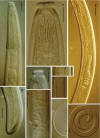.
Tylencholaimellus zeiabadensis: A. Female
anterior; B: Odontostyle and odontophore; C:Amphidial pouch; D:
Posterior female; E: Gonad, female; F: Vulva; G: Lateral chord; H:
Vagina and anterior-uterine sac; I,J: Enture body
Slide downloaded from Vazifeh et al., 2019
|
 Anterior
region of Tylencholaimellus zeinabadensis (from Vazifeh et al.,
2019) Anterior
region of Tylencholaimellus zeinabadensis (from Vazifeh et al.,
2019)
-
Moderately slender to slender nematodes of
medium size, 1.2-1.7 mm long.
-
Cuticle dorylaimid, two-layered, 3-4 μm
thick in anterior region, 4-6 μm
at mid-body and 7-12 μm
on tail, outer layer thin, with distinct radial striation.
-
Lateral chord occupying one-fifth to
one-fourth of mid-body diam.
-
Lip region offset by deep and broad
constriction, somewhat discoid, with nearly flat anterior margin,
2.7-4.0 times as wide as high and one-fifth to one-fourth of body
diam. at esophagus base, lips mostly amalgamated, with low labial
and cephalic papillae.
-
Amphidial fovea cup-like, aperture
occupying t2/3 to 3/4 of lip region diam.
-
Odontostyle typical of genus, 1.2-2.0 lip
region diam. long, dorsal stiffening piece covering entire dorsal
arm, aperture very short, about 1/9 of total length. Guiding ring
simple, located at one lip region diam. from anterior end.
-
Odontophore 30-60% of odontostyle length,
with distinct basal knobs 3-6 μm
broad
-
Esophagus with a slender, weakly muscular
anterior region, and a nearly cylindrical basal bulb occupying
12-23% of total esophagus length.
-
Cardia short, hemispherical, 3.5-6 × 6-12 μm.
-
Prerectum 1.4-3.6 and rectum 0.5-1.0 anal
body diam. long.
-
Tail short and rounded to conoid, slightly
more straight on its ventral contour
Female:
-
Monodelphic-opisthodelphic; anterior genital
branch reduced to a simple uterine sac, occasionally with
sperm cells inside. Posterior branch with ovary reflexed, not
reaching oviduct-uterus junction
-
Oocytes arranged first in two or more rows,
then in a single row, oviduct joining ovary subterminally,
-
Oviduct and uterus separated by a weak
sphincter,
-
Uterus a simple tube-like structure often
containing sperm cells.
-
Vagina perpendicular to body axis, extending
inwards for 34-56% of body diam., with pars
proximalis 14-18 μm
long and surrounded by weak circular musculature, and pars
distalis 4-7.5 μm
long.
-
Vulva a transverse slit.
|
|
Males:
- Genital system diorchic, with opposed testes.
- Sperm cells spindle-shaped,
- In addition to adcloacal pair there are one or two ventromedian
supplements at 35-64 μm,
55-60 μm from cloacal aperture
- Spicules dorylaimid, moderately sclerotised, comparatively
slender, weakly curved ventrad, and 1.1-2.0 times body diam. at
cloacal aperture long,
|